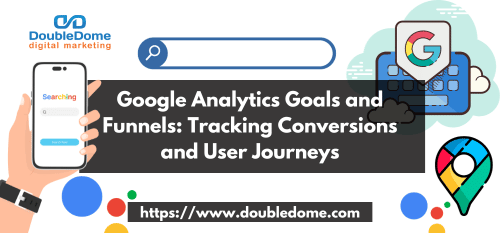By Jo Medico
In the dynamic realm of online business, understanding user behavior is essential. Enter Google Analytics, a powerful tool that not only provides insights into website traffic but also lets you track conversions and user journeys. In this comprehensive guide, we’ll delve into the intricacies of Google Analytics goals and funnels, unlocking the secrets to optimizing your website’s performance.

Unveiling the Power of Google Analytics
Understanding Google Analytics Goals
Google Analytics goals are the foundation of effective conversion tracking. They allow you to define specific actions you want users to take on your website, whether it’s making a purchase, signing up for a newsletter, or completing a form.
Setting Up Goals in Google Analytics
Let’s walk through the process of setting up goals. Navigate to your Google Analytics account, select the property you want, and under the “Admin” tab, click on “Goals.” Follow the prompts to define your goals, ensuring they align with your business objectives.
Crafting User Journeys with Funnels
Introduction to Funnels
Funnels provide a visual representation of the user journey, illustrating the steps users take before completing a goal. This insight is invaluable for optimizing your website and enhancing the user experience.
Building Effective Funnels
Crafting a funnel involves mapping out the steps users take, from landing on your site to completing a conversion. Identify potential drop-off points and refine your funnel to streamline the user journey.
The Perplexity of User Behavior
Navigating Perplexity in Analytics
User behavior is often perplexing, but Google Analytics helps unravel the mystery. Analyze user interactions, time spent on pages, and the most common paths through your site to gain a deeper understanding of your audience.
Burstiness: A Key to Optimization
Burstiness in Analytics
Burstiness refers to sudden spikes in user activity. Recognizing these bursts can help you capitalize on trends, refine your content strategy, and align your marketing efforts with peak user interest.
Enhancing Specificity Without Losing Context
Balancing Specificity and Context
While diving into specifics is crucial for optimization, maintaining context is equally important. Strike a balance by providing detailed insights without overwhelming your audience.
Engaging Readers with Conversational Writing
The Power of Conversational Style
We believe in the effectiveness of a conversational tone. It not only makes complex topics more approachable but also keeps readers engaged throughout the content.
Weaving Rhetorical Questions, Analogies, and Metaphors
Rhetorical Questions and Analogies
Ever wondered how user journeys are like a road trip? Engage your readers by weaving rhetorical questions, analogies, and metaphors into your content to make it relatable and memorable.
Conclusion
Mastering Google Analytics goals and funnels is the key to unlocking your website’s full potential. By understanding user behavior, navigating perplexity, and capitalizing on burstiness, you can elevate your online presence and drive conversions.








